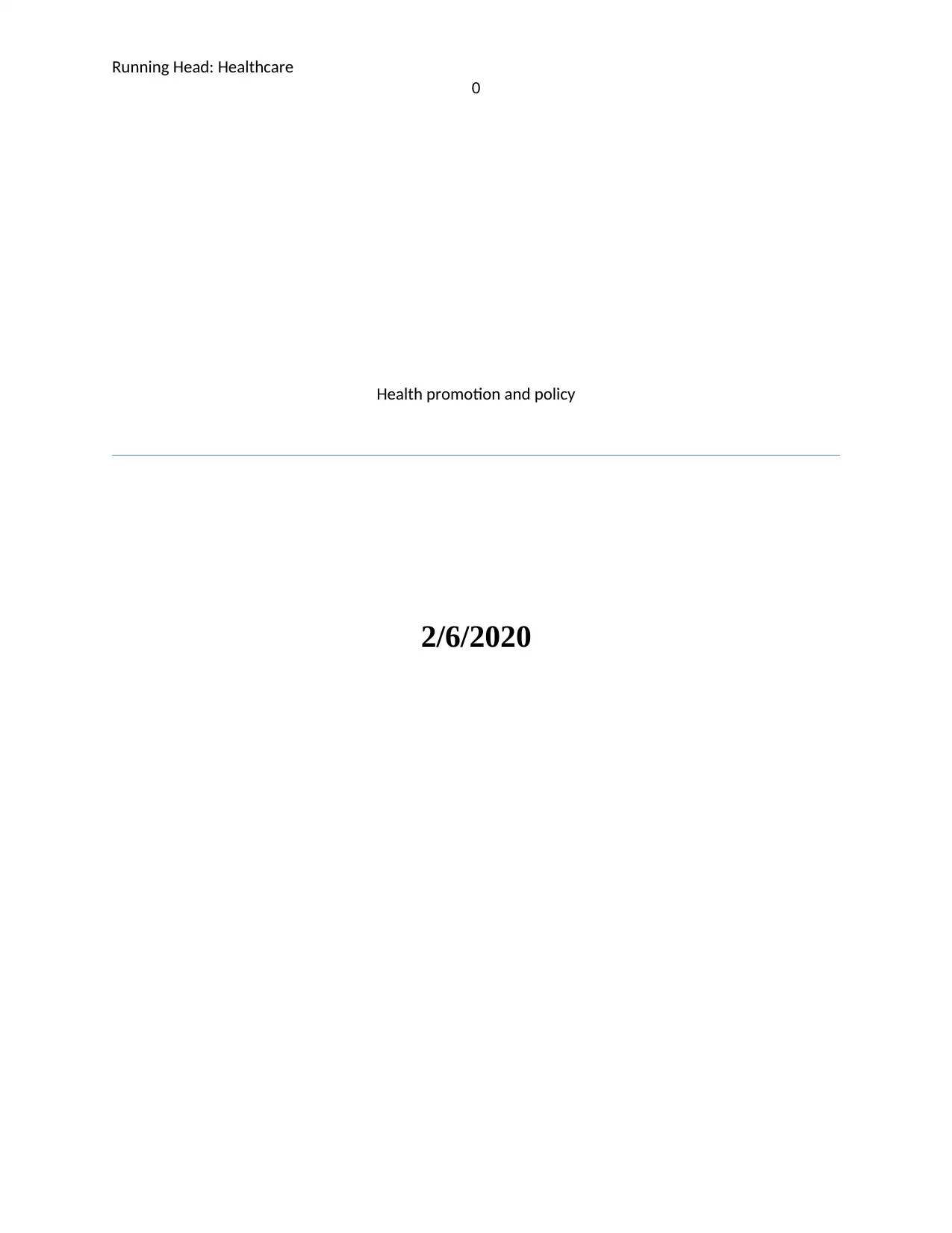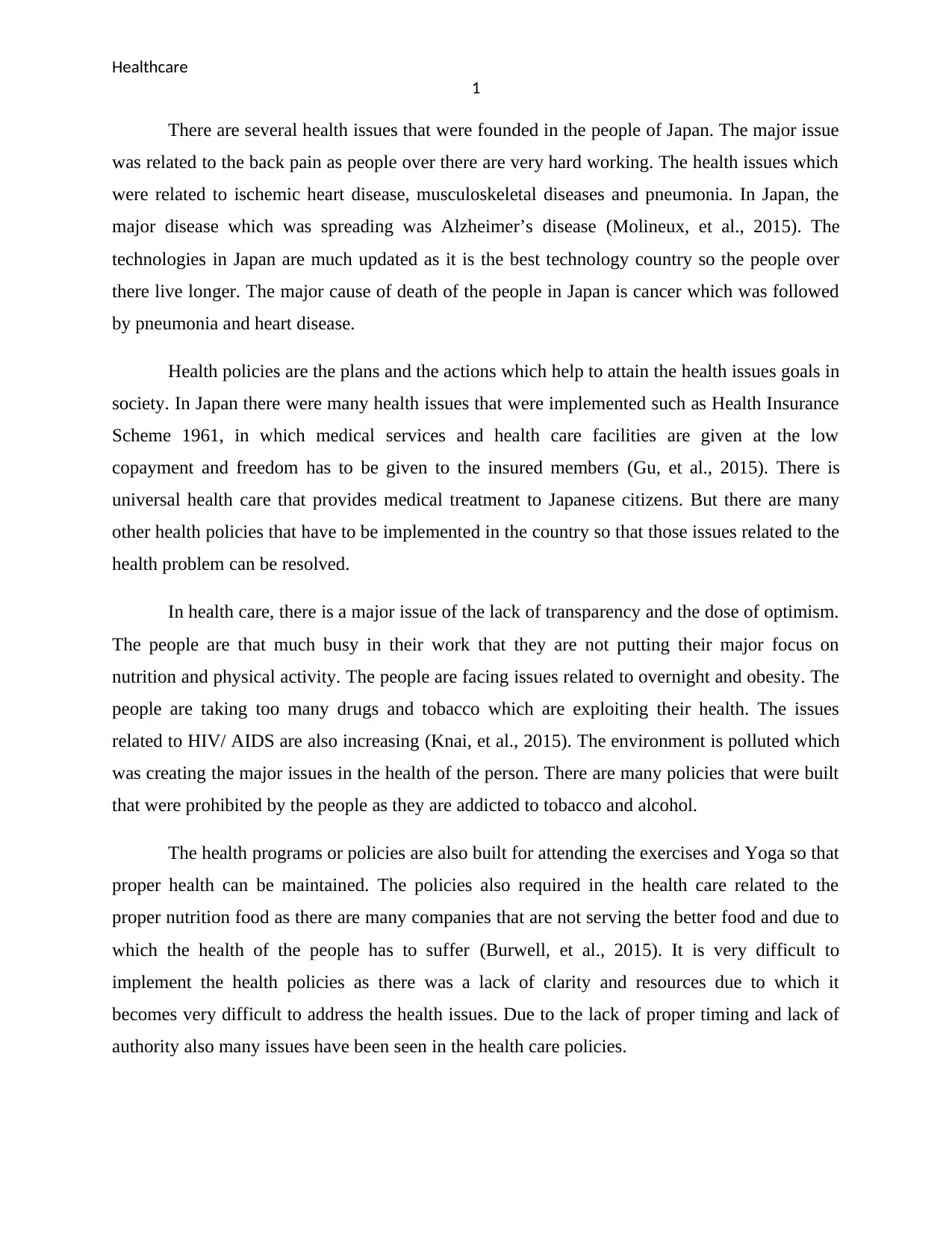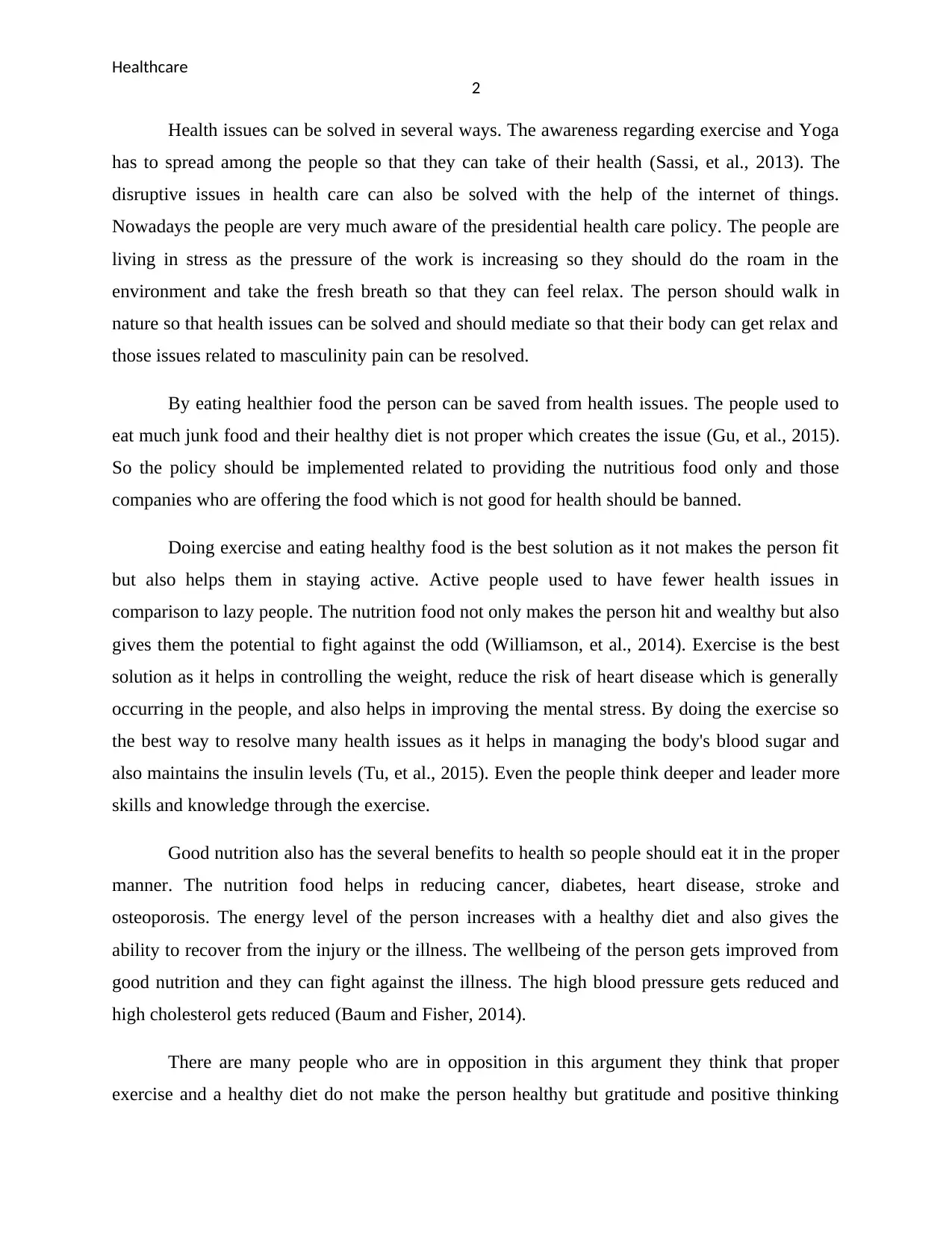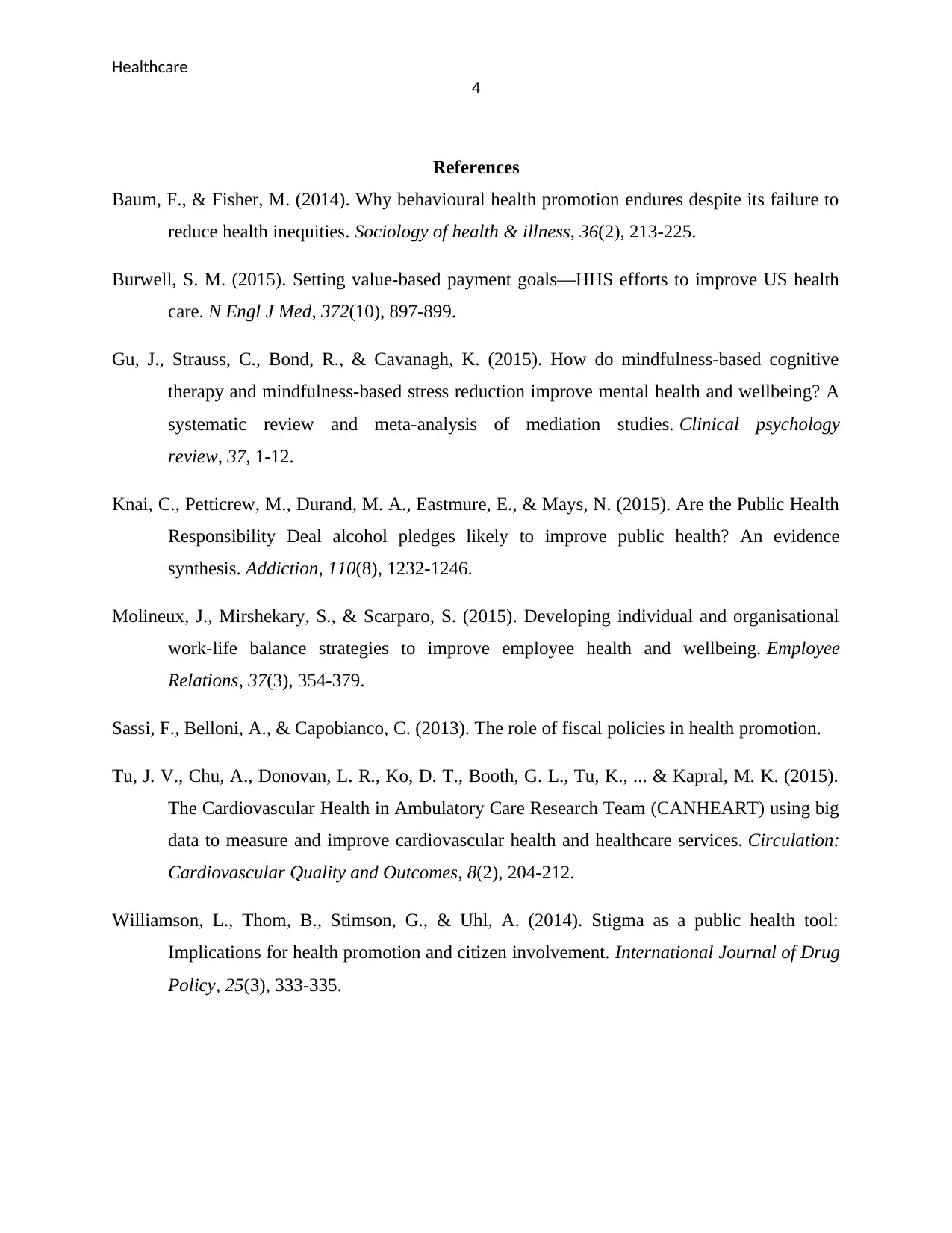Comprehensive Report: Health Promotion and Policy in Japan
VerifiedAdded on 2022/08/19
|5
|1414
|15
Report
AI Summary
This report examines various health issues in Japan, including ischemic heart disease, musculoskeletal diseases, pneumonia, and Alzheimer's disease, highlighting the impact of the country's advanced technology and aging population. It discusses the implementation of health policies, such as the Health Insurance Scheme of 1961 and universal healthcare, while also addressing the challenges of lack of transparency, poor nutrition, drug and tobacco use, and environmental pollution. The report emphasizes the importance of health promotion through exercise, yoga, healthy eating, and the use of technology to solve healthcare problems. It also mentions the significance of awareness regarding exercise and yoga, the benefits of nutritious food, and the role of exercise in managing weight, reducing heart disease risk, and improving mental stress. The report concludes by acknowledging the difficulties in implementing health policies but emphasizes the potential for improvement through proper exercise and a nutritious diet, and the role of positive thinking and sleep.

Running Head: Healthcare
0
Health promotion and policy
2/6/2020
0
Health promotion and policy
2/6/2020
Paraphrase This Document
Need a fresh take? Get an instant paraphrase of this document with our AI Paraphraser

Healthcare
1
There are several health issues that were founded in the people of Japan. The major issue
was related to the back pain as people over there are very hard working. The health issues which
were related to ischemic heart disease, musculoskeletal diseases and pneumonia. In Japan, the
major disease which was spreading was Alzheimer’s disease (Molineux, et al., 2015). The
technologies in Japan are much updated as it is the best technology country so the people over
there live longer. The major cause of death of the people in Japan is cancer which was followed
by pneumonia and heart disease.
Health policies are the plans and the actions which help to attain the health issues goals in
society. In Japan there were many health issues that were implemented such as Health Insurance
Scheme 1961, in which medical services and health care facilities are given at the low
copayment and freedom has to be given to the insured members (Gu, et al., 2015). There is
universal health care that provides medical treatment to Japanese citizens. But there are many
other health policies that have to be implemented in the country so that those issues related to the
health problem can be resolved.
In health care, there is a major issue of the lack of transparency and the dose of optimism.
The people are that much busy in their work that they are not putting their major focus on
nutrition and physical activity. The people are facing issues related to overnight and obesity. The
people are taking too many drugs and tobacco which are exploiting their health. The issues
related to HIV/ AIDS are also increasing (Knai, et al., 2015). The environment is polluted which
was creating the major issues in the health of the person. There are many policies that were built
that were prohibited by the people as they are addicted to tobacco and alcohol.
The health programs or policies are also built for attending the exercises and Yoga so that
proper health can be maintained. The policies also required in the health care related to the
proper nutrition food as there are many companies that are not serving the better food and due to
which the health of the people has to suffer (Burwell, et al., 2015). It is very difficult to
implement the health policies as there was a lack of clarity and resources due to which it
becomes very difficult to address the health issues. Due to the lack of proper timing and lack of
authority also many issues have been seen in the health care policies.
1
There are several health issues that were founded in the people of Japan. The major issue
was related to the back pain as people over there are very hard working. The health issues which
were related to ischemic heart disease, musculoskeletal diseases and pneumonia. In Japan, the
major disease which was spreading was Alzheimer’s disease (Molineux, et al., 2015). The
technologies in Japan are much updated as it is the best technology country so the people over
there live longer. The major cause of death of the people in Japan is cancer which was followed
by pneumonia and heart disease.
Health policies are the plans and the actions which help to attain the health issues goals in
society. In Japan there were many health issues that were implemented such as Health Insurance
Scheme 1961, in which medical services and health care facilities are given at the low
copayment and freedom has to be given to the insured members (Gu, et al., 2015). There is
universal health care that provides medical treatment to Japanese citizens. But there are many
other health policies that have to be implemented in the country so that those issues related to the
health problem can be resolved.
In health care, there is a major issue of the lack of transparency and the dose of optimism.
The people are that much busy in their work that they are not putting their major focus on
nutrition and physical activity. The people are facing issues related to overnight and obesity. The
people are taking too many drugs and tobacco which are exploiting their health. The issues
related to HIV/ AIDS are also increasing (Knai, et al., 2015). The environment is polluted which
was creating the major issues in the health of the person. There are many policies that were built
that were prohibited by the people as they are addicted to tobacco and alcohol.
The health programs or policies are also built for attending the exercises and Yoga so that
proper health can be maintained. The policies also required in the health care related to the
proper nutrition food as there are many companies that are not serving the better food and due to
which the health of the people has to suffer (Burwell, et al., 2015). It is very difficult to
implement the health policies as there was a lack of clarity and resources due to which it
becomes very difficult to address the health issues. Due to the lack of proper timing and lack of
authority also many issues have been seen in the health care policies.

Healthcare
2
Health issues can be solved in several ways. The awareness regarding exercise and Yoga
has to spread among the people so that they can take of their health (Sassi, et al., 2013). The
disruptive issues in health care can also be solved with the help of the internet of things.
Nowadays the people are very much aware of the presidential health care policy. The people are
living in stress as the pressure of the work is increasing so they should do the roam in the
environment and take the fresh breath so that they can feel relax. The person should walk in
nature so that health issues can be solved and should mediate so that their body can get relax and
those issues related to masculinity pain can be resolved.
By eating healthier food the person can be saved from health issues. The people used to
eat much junk food and their healthy diet is not proper which creates the issue (Gu, et al., 2015).
So the policy should be implemented related to providing the nutritious food only and those
companies who are offering the food which is not good for health should be banned.
Doing exercise and eating healthy food is the best solution as it not makes the person fit
but also helps them in staying active. Active people used to have fewer health issues in
comparison to lazy people. The nutrition food not only makes the person hit and wealthy but also
gives them the potential to fight against the odd (Williamson, et al., 2014). Exercise is the best
solution as it helps in controlling the weight, reduce the risk of heart disease which is generally
occurring in the people, and also helps in improving the mental stress. By doing the exercise so
the best way to resolve many health issues as it helps in managing the body's blood sugar and
also maintains the insulin levels (Tu, et al., 2015). Even the people think deeper and leader more
skills and knowledge through the exercise.
Good nutrition also has the several benefits to health so people should eat it in the proper
manner. The nutrition food helps in reducing cancer, diabetes, heart disease, stroke and
osteoporosis. The energy level of the person increases with a healthy diet and also gives the
ability to recover from the injury or the illness. The wellbeing of the person gets improved from
good nutrition and they can fight against the illness. The high blood pressure gets reduced and
high cholesterol gets reduced (Baum and Fisher, 2014).
There are many people who are in opposition in this argument they think that proper
exercise and a healthy diet do not make the person healthy but gratitude and positive thinking
2
Health issues can be solved in several ways. The awareness regarding exercise and Yoga
has to spread among the people so that they can take of their health (Sassi, et al., 2013). The
disruptive issues in health care can also be solved with the help of the internet of things.
Nowadays the people are very much aware of the presidential health care policy. The people are
living in stress as the pressure of the work is increasing so they should do the roam in the
environment and take the fresh breath so that they can feel relax. The person should walk in
nature so that health issues can be solved and should mediate so that their body can get relax and
those issues related to masculinity pain can be resolved.
By eating healthier food the person can be saved from health issues. The people used to
eat much junk food and their healthy diet is not proper which creates the issue (Gu, et al., 2015).
So the policy should be implemented related to providing the nutritious food only and those
companies who are offering the food which is not good for health should be banned.
Doing exercise and eating healthy food is the best solution as it not makes the person fit
but also helps them in staying active. Active people used to have fewer health issues in
comparison to lazy people. The nutrition food not only makes the person hit and wealthy but also
gives them the potential to fight against the odd (Williamson, et al., 2014). Exercise is the best
solution as it helps in controlling the weight, reduce the risk of heart disease which is generally
occurring in the people, and also helps in improving the mental stress. By doing the exercise so
the best way to resolve many health issues as it helps in managing the body's blood sugar and
also maintains the insulin levels (Tu, et al., 2015). Even the people think deeper and leader more
skills and knowledge through the exercise.
Good nutrition also has the several benefits to health so people should eat it in the proper
manner. The nutrition food helps in reducing cancer, diabetes, heart disease, stroke and
osteoporosis. The energy level of the person increases with a healthy diet and also gives the
ability to recover from the injury or the illness. The wellbeing of the person gets improved from
good nutrition and they can fight against the illness. The high blood pressure gets reduced and
high cholesterol gets reduced (Baum and Fisher, 2014).
There are many people who are in opposition in this argument they think that proper
exercise and a healthy diet do not make the person healthy but gratitude and positive thinking
⊘ This is a preview!⊘
Do you want full access?
Subscribe today to unlock all pages.

Trusted by 1+ million students worldwide

Healthcare
3
help in building the immune system healthy. The overall health of the person gets boosted by
taking the proper sleep also. So from this, it is evaluated that health policies are difficult to
implement and there are many health issues but it can be solved through proper exercise and a
good nutrition diet (Knai, et al., 2015).
3
help in building the immune system healthy. The overall health of the person gets boosted by
taking the proper sleep also. So from this, it is evaluated that health policies are difficult to
implement and there are many health issues but it can be solved through proper exercise and a
good nutrition diet (Knai, et al., 2015).
Paraphrase This Document
Need a fresh take? Get an instant paraphrase of this document with our AI Paraphraser

Healthcare
4
References
Baum, F., & Fisher, M. (2014). Why behavioural health promotion endures despite its failure to
reduce health inequities. Sociology of health & illness, 36(2), 213-225.
Burwell, S. M. (2015). Setting value-based payment goals—HHS efforts to improve US health
care. N Engl J Med, 372(10), 897-899.
Gu, J., Strauss, C., Bond, R., & Cavanagh, K. (2015). How do mindfulness-based cognitive
therapy and mindfulness-based stress reduction improve mental health and wellbeing? A
systematic review and meta-analysis of mediation studies. Clinical psychology
review, 37, 1-12.
Knai, C., Petticrew, M., Durand, M. A., Eastmure, E., & Mays, N. (2015). Are the Public Health
Responsibility Deal alcohol pledges likely to improve public health? An evidence
synthesis. Addiction, 110(8), 1232-1246.
Molineux, J., Mirshekary, S., & Scarparo, S. (2015). Developing individual and organisational
work-life balance strategies to improve employee health and wellbeing. Employee
Relations, 37(3), 354-379.
Sassi, F., Belloni, A., & Capobianco, C. (2013). The role of fiscal policies in health promotion.
Tu, J. V., Chu, A., Donovan, L. R., Ko, D. T., Booth, G. L., Tu, K., ... & Kapral, M. K. (2015).
The Cardiovascular Health in Ambulatory Care Research Team (CANHEART) using big
data to measure and improve cardiovascular health and healthcare services. Circulation:
Cardiovascular Quality and Outcomes, 8(2), 204-212.
Williamson, L., Thom, B., Stimson, G., & Uhl, A. (2014). Stigma as a public health tool:
Implications for health promotion and citizen involvement. International Journal of Drug
Policy, 25(3), 333-335.
4
References
Baum, F., & Fisher, M. (2014). Why behavioural health promotion endures despite its failure to
reduce health inequities. Sociology of health & illness, 36(2), 213-225.
Burwell, S. M. (2015). Setting value-based payment goals—HHS efforts to improve US health
care. N Engl J Med, 372(10), 897-899.
Gu, J., Strauss, C., Bond, R., & Cavanagh, K. (2015). How do mindfulness-based cognitive
therapy and mindfulness-based stress reduction improve mental health and wellbeing? A
systematic review and meta-analysis of mediation studies. Clinical psychology
review, 37, 1-12.
Knai, C., Petticrew, M., Durand, M. A., Eastmure, E., & Mays, N. (2015). Are the Public Health
Responsibility Deal alcohol pledges likely to improve public health? An evidence
synthesis. Addiction, 110(8), 1232-1246.
Molineux, J., Mirshekary, S., & Scarparo, S. (2015). Developing individual and organisational
work-life balance strategies to improve employee health and wellbeing. Employee
Relations, 37(3), 354-379.
Sassi, F., Belloni, A., & Capobianco, C. (2013). The role of fiscal policies in health promotion.
Tu, J. V., Chu, A., Donovan, L. R., Ko, D. T., Booth, G. L., Tu, K., ... & Kapral, M. K. (2015).
The Cardiovascular Health in Ambulatory Care Research Team (CANHEART) using big
data to measure and improve cardiovascular health and healthcare services. Circulation:
Cardiovascular Quality and Outcomes, 8(2), 204-212.
Williamson, L., Thom, B., Stimson, G., & Uhl, A. (2014). Stigma as a public health tool:
Implications for health promotion and citizen involvement. International Journal of Drug
Policy, 25(3), 333-335.
1 out of 5
Related Documents
Your All-in-One AI-Powered Toolkit for Academic Success.
+13062052269
info@desklib.com
Available 24*7 on WhatsApp / Email
![[object Object]](/_next/static/media/star-bottom.7253800d.svg)
Unlock your academic potential
Copyright © 2020–2025 A2Z Services. All Rights Reserved. Developed and managed by ZUCOL.





